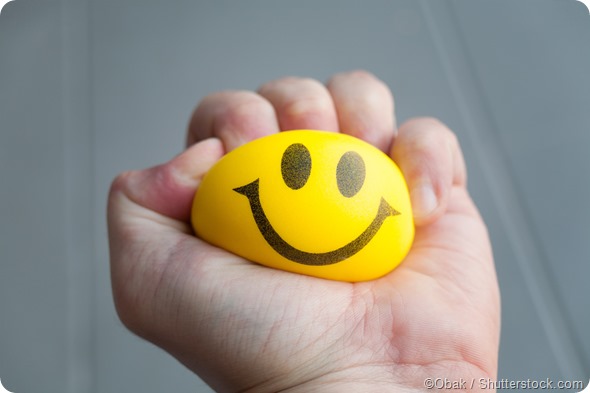An interview with Adam Anderson, Chief Neuroscience Officer at Zenytime, conducted by April Cashin-Garbutt, MA (Cantab)
What is the definition of stress and how has it traditionally been measured?
The term “stress” originates not in our minds or bodies, but from physics. It is the internal forces generated in an object in response to an external load.
In the 1950s, Hans Selye adopted the term to characterize how living organisms change in response to environmental conditions. When applied to biological systems, stress is a physiological response to any challenge or stressor, whether physical or mental, real or imagined.

Subjectively and physiologically, it is a movement of the mind away from relaxation and the body away from homeostasis, to respond to the challenges presented by the environment.
It is important to remember that although “stress” has negative connotations, from an evolutionary perspective, we can’t survive without it. Stress exists to help, not to hurt us.
Without physiological stress our bodies could not muster up the energy to tackle the most basic of challenges, from lifting that heavy weight, walking up a steep hill, to focusing our attention to meet a looming deadline. So we should not get stressed-out by experiencing short bouts of stress. Only toxic stress is damaging.
Stress is best measured where our brains and bodies meet, in the Autonomic Nervous System (ANS). To deal with the stressor, the brain orchestrates the sympathetic branch of the ANS and neuroendocrine responses, which in conjunction dramatically alter bodily physiology, such as blood pressure, vascular tone, and cardiorespiratory dynamics.
While stress can be measured through steroids in the blood (e.g., adrenalin, cortisol), much more than blood chemistry, the most direct measurement of stress physiology lies in changes in organ function, including the brain itself.
When is stress considered toxic and what impact can it have on the body?
When working as intended, stress responses occur at the appropriate times and amounts to match the demands of the environmental stressor, no more and no less. Toxic stress occurs when the stress is too easily engaged and unable to be turned off, developing into a chronic condition. The stress response no longer matches the demands of the environment, in terms of when and how much is needed.
Subjective distress is just the tip of the stress iceberg. Many individuals may not even feel their stress levels are too high for it to be toxic. Our brains and bodies were not meant for stress over the long haul. It is too energy-demanding, having toxic consequences.
Like going on too drastic of a diet, under chronic stress the body starts to consume itself, including muscle, bone and brain, to support its energy needs. Decades of research has shown that chronic stress results in detrimental physiological consequences, from cardiovascular disease, diminished immune response, to degrading the white and grey matter in your brain.
So in the long-term, the damaging effects of toxic stress are something that we should get stressed about. However, rather than getting further stressed, it is best to do something about it.
How much evidence is there that breathing techniques can modify how your brain controls stress?
You don't need a biopsy or a blood sample to measure the wear and tear of toxic stress on the brain and body. Toxic stress is best diagnosed, and managed, at the junction between the brain and body — the ANS.
Breathing is also a controller of the balance between the two branches of the ANS, the sympathetic (activating) and parasympathetic (relaxing). While breathing takes place in the body, it is controlled by the brain (you can hold your breath until you faint), providing a direct means to alter our physiology.
Mirroring acute stress, chronic stress results in an enduring increase in sympathetic and diminished parasympathetic communication between the body and the brain. Diminished parasympathetic activity is a harbinger for a number of conditions and the progression of existing ones.
Counteracting the acute and long term effects of stress, low, constant depth .1 Hz breathing (6 times a minute) maximizes parasympathetic activity by engaging the vagal nerve, which connect the brain with most of our internal organs.
Taking deep slow breaths to deal with acute stress engages a parasympathetic relaxation response, giving a short term parasympathetic boost. This decreases the brain’s ability to communicate stress signals to the body, like a stress filter.
However, a few deep breaths won’t do much for chronic stress. Participating in daily .1 Hz breathing exercises has been shown to slow one’s default breathing rate. Better yet, it can result in an enduring increase in the parasympathetic communication between your brain and body.
This allows better regulation of emotions and acute stress, supporting grace under pressure. It also replaces chronic stress’ dominant sympathetic mode with a parasympathetic one, and all the restorative and health promoting functions that come along with it.

Zenytime makes .1Hz breathing simple and fun, providing guidance through engaging gameplay that is controlled by the air of your breath. The “Puck” contains a multiple patented air-flow sensor that opens up a new world of interacting with your mobile device, all while coaching and training your breathing towards an easy .1 Hz rhythm.
Through analysis of your breathing and the pulse at your finger tip, increased parasympathetic engagement is measured both in the moment, and as a trend over time.
Zenytime was developed with self-quantification and self-improvement in mind; it combines advanced biosensing, cutting edge gamification technology and comprehensive analytics in a wellness program designed to motivate, educate and reward consumers to do better.
Zenytime takes population health management to the next level by merging assessment and intervention in one single, interactive and gamified solution.
Zenytime
What biomarkers do you measure?
Zenytime has developed myPowers daily indicators derived from distinct physiological biomarkers. The flow of air is assessed by the Puck to control gameplay but also to acquire information on breath quality and frequency. The ability to generate smooth constant .1 Hz airflow is indexed via BreathPower.
Direct breathing assessment also allows the most rigorous characterization of ANS activity. Heart Rate Variability (HRV) is a large family of over 70 biomarkers that are used to characterize the ANS, reflecting the brain’s regulation of sympathetic and parasympathetic activity.
Anti-stress parasympathetic activity is specifically indexed by the Respiratory Sinus Arrhythmia (RSA) biomarker, which is the waxing and waning of heart rate with each breath. The magnitude of RSA is maximal at .1 Hz providing a strong and clear parasympathetic anti-stress signal to the body and is indexed via BodyPower.
Over time, the short term physiological boosts in BodyPower provided by .1 Hz practice can transform the brain to have enduring regulatory effects over the ANS. The ability to sustain parasympathetic BodyPower is indexed via BrainPower, which captures the brain’s capacity to not only regulate the body but also itself, enhancing neuroplasticity, towards a more stress resistant brain.
While gameplay is fun, it also serves as a scientific protocol that allows maximal sensitivity for picking up on these biomarkers and the derivation of myPowers. A common protocol allows accurate comparisons with yourself over time and with your peers undergoing the same protocol.
Gameplay protocols have many built in challenges that serve as obstacle courses for your breathing and ANS, to assess how our physiology responds during mental stressors.
Has the Zenytime Puck been scientifically tested?
The scientific foundations of Zenytime and the Puck have been established in over 20,000 studies examining how ANS activity is associated with body and brain health, and the mediating role of chronic stress.
The capacity of .1 Hz breathing to alter ANS activity, and to maximize RSA, has been long known and shown across many species. Zenytime combines this scientific and clinical knowledge, with a unique breath sensor, and engaging gameplay to increase its accessibility for population health management.
The unique breath-sensitive MEMS sensor inside Zenytime has been granted more than 20 patents with more than 30 pending worldwide, the sensor has been developed and tested for more than five years
What feedback have you received from users?
Zenytime is currently deploying its program with a number of companies, including Fortune 500 and healthcare organizations. The program includes a 30-day challenge and comprehensive metrics and analytics in addition to games Zenytime releases regularly, designed to foster engagement.
Zenytime's platform is crowdsourcing repeated measurements on an unprecedented scale to characterize the healthy and unhealthy biomarkers of everyday stress and its potential unique fingerprint in every individual. In addition, Zenytime is working on Case Studies to be released in Q1 2017.
How does the Zenytime Puck compare to other products on the market?
While there are many stress reduction offerings, Zenytime’s combination of ANS biosensing with gamified stress challenges controlled by your breath is highly unique. This unique combination with patented breath sensing provides unprecedented monitoring and management of toxic stress.
In what ways do Zenytime hope to advance the technology moving forward?
Our vision is to provide stress toxicity monitoring with the ease of use, interpretability and reliability of a thermometer. A thermometer that not only measures your temperature but also intervenes, reducing your fever.
We are working to merge new technologies with existing biological ones. The oldest and most sophisticated biosensing device ever created is the human brain. Our mission is to use newer tech to tap into what an individual’s brain knows about the status of itself and the body, and in turn to harness the brain’s capacity for healing.
What do you think the future holds for stress testing and management?
A larger mission is to engage individuals in scientific self-study—by providing an easy-to-use and easy-to-understand self-laboratory. Knowledge on our own and our peer’s health and wellness, plus the tools to manage it, empowers people to better monitor and manage their own self-care. More than the rare visit to professional health care provider to gauge the effects of stress on our lives, every day we can be empowered to be aware of our toxic stress and to something about it.
Where can readers find more information?
About Adam Anderson
 Adam Anderson is Associate Professor in Human Development and Human Neuroscience Institute at Cornell University.
Adam Anderson is Associate Professor in Human Development and Human Neuroscience Institute at Cornell University.
He is a leading authority on the psychology and neuroscience of emotions, and the recipient of early career awards for his transformational work in emotional neuroscience by the American Psychological Association and Cognitive Neuroscience Society.
His work is often featured in popular media as well as international museums, and was recently highlighted in Discover Magazine top discoveries for his work on “cracking the emotional code” of the human brain.